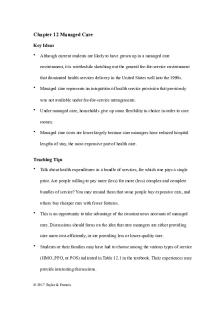Chapter 12 QUIZ - MS.WONG PDF

| Title | Chapter 12 QUIZ - MS.WONG |
|---|---|
| Author | Ivan Low |
| Course | Marketing |
| Institution | Sunway University |
| Pages | 3 |
| File Size | 105.6 KB |
| File Type | |
| Total Downloads | 619 |
| Total Views | 808 |
Summary
CHAPTER 12 QUIZ Major influences of competitors, costs, and customers on pricing decisions are factors of a. supply and demand. b. activity-based costing and activity-based management. c. key management themes that are important to managers attaining success in their planning and control decisions. ...
Description
CHAPTER 12 QUIZ 1. Major influences of competitors, costs, and customers on pricing decisions are factors of a. supply and demand. b. activity-based costing and activity-based management. c. key management themes that are important to managers attaining success in their planning and control decisions. d. the value-chain concept. 2. Short-run pricing decisions include a. pricing a main product in a major market. b. considering all costs in the value chain of business functions. c. adjusting product mix and volume in a competitive market while maintaining a stable price if demand fluctuates from strong to weak. d. pricing for a special order with no long-term implications. 3. Burkhart Company manufactures a product that has a variable cost of $25 per unit. Fixed costs total $1,000,000, allocated on the basis of the number of units produced. Selling price is computed by adding a 25% markup to full cost. How much should the selling price be per unit for 200,000 units? a. $31.25 b. $42.00 c. $37.50 d. $30.00 4. The first step in implementing target pricing and target costing is a. choosing a target price. b. determining a target cost. c. developing a product that satisfies needs of potential customers. d. performing value engineering. 5. The best opportunity for cost reduction is a. during the manufacturing phase of the value chain. b. during the product/process design phase of the value chain. c. during the marketing phase of the value chain. d. during the distribution phase of the value chain. The following data apply to questions 6 and 7. Each month, Haddon Company has $275,000 total manufacturing costs (20% fixed) and $125,000 distribution and marketing costs (36% fixed). Haddon’s monthly sales are $500,000. 6. The markup percentage on full cost to arrive at the target (existing) selling price is a. 25%. b. 75%. c. 80%. d. 20%.
156
7. The markup percentage on variable costs to arrive at the existing (target) selling price is a. 20%. b. 40%. c. 80%. d.
66
2 3
%.
8. The price of movie tickets for opening day and the few days following compared to the price six months later is an example of a. price gouging. b. peak-load pricing. c. dumping. d. demand elasticity. 9. Price discrimination is always illegal. a type of peak-load pricing. not regulated in the United States. the practice of charging different prices to different customers for the same product or service. 10. Which of these do antitrust laws on pricing not cover? a. Collusive pricing b. Dumping c. Peak-load pricing d. Predatory pricing
157
CHAPTER 12 QUIZ SOLUTIONS 1.
a
2.
d
3.
c
4.
c
5.
b
6.
a
7.
d
8.
b
9.
d
10.
c
Quiz Question Calculations
3.
6.
7.
Variable cost Fixed cost Full cost
$25.00 5.00 ($1,000,000/200,000 units) $30.00
25% Markup Selling price
7.50 $37.50
Manufacturing costs Distribution & Marketing costs Total cost
$275,000 125,000 $400,000
Sales Full cost Profit
Markup Full cost
$500,000 $400,000 $100,000
Variable manufacturing Variable dist/marketing Total Variable cost Sales VC Markup
$500,000 300,000 $200,000
$100,000 $400,000
= 25%
$275.000 80% $125,000 64%
= =
$220,000 80,000 $300,000
$200,000 $300,000
=
66 2/3%
158...
Similar Free PDFs

Chapter 12 Quiz - Weekly Quiz
- 3 Pages

Chapter 12 quiz
- 12 Pages

Chapter 12 Quiz Answers
- 12 Pages

Chapter 12 QUIZ - MS.WONG
- 3 Pages

Chapter 12 - Quiz solution
- 12 Pages

Quiz for Chapter 12
- 9 Pages

ACC270- Chapter 12 Quiz
- 8 Pages

Quiz-12-solutions - quiz 12
- 3 Pages

Quiz 12 620 - quiz 12
- 5 Pages

Chapter 12 quiz - Nervous system
- 1 Pages

BCIS 4350 - Chapter 12 Quiz
- 7 Pages
Popular Institutions
- Tinajero National High School - Annex
- Politeknik Caltex Riau
- Yokohama City University
- SGT University
- University of Al-Qadisiyah
- Divine Word College of Vigan
- Techniek College Rotterdam
- Universidade de Santiago
- Universiti Teknologi MARA Cawangan Johor Kampus Pasir Gudang
- Poltekkes Kemenkes Yogyakarta
- Baguio City National High School
- Colegio san marcos
- preparatoria uno
- Centro de Bachillerato Tecnológico Industrial y de Servicios No. 107
- Dalian Maritime University
- Quang Trung Secondary School
- Colegio Tecnológico en Informática
- Corporación Regional de Educación Superior
- Grupo CEDVA
- Dar Al Uloom University
- Centro de Estudios Preuniversitarios de la Universidad Nacional de Ingeniería
- 上智大学
- Aakash International School, Nuna Majara
- San Felipe Neri Catholic School
- Kang Chiao International School - New Taipei City
- Misamis Occidental National High School
- Institución Educativa Escuela Normal Juan Ladrilleros
- Kolehiyo ng Pantukan
- Batanes State College
- Instituto Continental
- Sekolah Menengah Kejuruan Kesehatan Kaltara (Tarakan)
- Colegio de La Inmaculada Concepcion - Cebu




